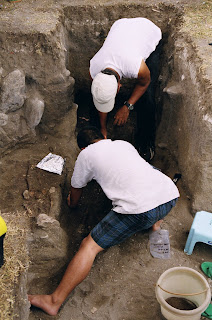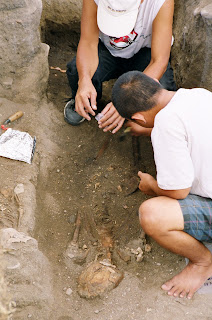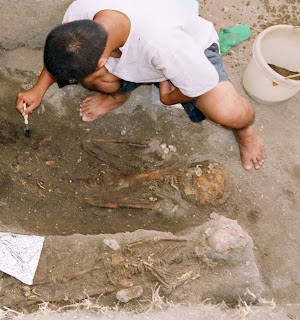About Boljoon
Boljoon is a coastal municipality, a hundred and three (103) kilometers away from Cebu City to the southeastern part of Cebu. It is positioned in such a way that it is bounded in the east by the sea and in the west by high mountains. Its name is said to be a derivative of the local word "bolho" which means springs of water.
Boljoon is said to be one of the oldest towns of Cebu. There is still dispute to the actual date of its creation. The town, according to local historians, was created in 1600, with the parish created the year after. However, a record in the Archives of the Augustinian Province of the Philippines states that the formal establishment of the parish was in 1692 . During Spanish colonization, there is not much difference between "town" and "parish". There is no separation between Church and State.
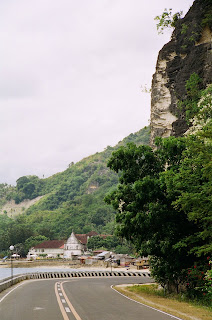 The roads to and in Boljoon are crooked. Towards the entrance to Poblacion, the heart of the town, visitors are greeted by the what the locals call as "Ili's enchanted drive". A road sign is posted warning drivers to sound the horns three times.
The roads to and in Boljoon are crooked. Towards the entrance to Poblacion, the heart of the town, visitors are greeted by the what the locals call as "Ili's enchanted drive". A road sign is posted warning drivers to sound the horns three times.The "enchanted drive" is in fact a winding road along the sides of Boljoon's elevated hill called "Ili". Beyond the hill side, the Boljoon Parish Church is visible with the coastline at its foreground.
The Arrival
We arrived early as expected, around 8AM. We travelled for just two hours. I was alerted a day before the travel that there are people digging for antique infront of Boljoon's parish chur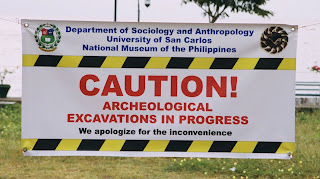 ch and that it would not be a good time to take pictures.
ch and that it would not be a good time to take pictures.
 ch and that it would not be a good time to take pictures.
ch and that it would not be a good time to take pictures.The bus stopped a few meters from the entrance of the church yard. The alert was indeed true. There were indeed some excavations in front of the church.
The signs told us that the excavations were not just all about antiques. It was an archaeological excavation.
We started taking pictures.
Patrocinio de Santa Maria
Media 'mo?
We wanted to takes pictures inside the church but it was closed. There were some women that have gathered in one of the excavation holes. Perhaps due to the camera I was carrying, I was asked if I am a member of the press. I was tempted to say that I was once, way back in high school. We conversed and eventually we learned that the "diggers" have found two sets of skeletons - that of a child and a grown up human with a dagger in its chest. Unfortunately, it was still covered and one man who seemed in command of the excavation team told the gathering crowd that it won't be opened for public view for a few more hours.
We decided to see more of Boljoon. We agreed to go to two watch towers as indicated in the municipality's map painted in a large board just outside of the municipality hall. After asking some locals, we hailed a motorcycle (called "habal-habal" in the dialect) to get us to the towers. First stop was a watch tower in Baluarte Granada. The small pavement road beside the highway leading to this high place was steep. It turned out that we entered a private property. The place was owned by a local married to a foreigner. It offered a great scenic view of Poblacion. They are developing the area and it would be open by April.
The Excavation Views
We headed to Ili Tower. When we passed by the church, a crowd was gathering in the tent where the skeletons were found. We decided to stop by and see for ourselves.
Indeed, there were skeletons.
There were two persons from the USC-National Museum team who answered questions from the crowd while two others where painstakingly brushing layers of soil to expose the skeletal remains.
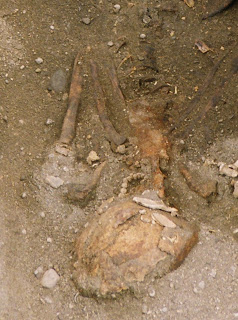 When we started taking pictures, the other people started clearing our way for us to have a closer view. They still think we are members of the press.
When we started taking pictures, the other people started clearing our way for us to have a closer view. They still think we are members of the press.Even the lady sitting beside the pit answering questions about the skeletons' age and at the same time giving instructions to the two persons below (such as not to touch and pulverize the charcoal) thought I was from the press.
A closer view of the adult skeleton showed that there is a dagger in its chest.
When we had enough pictures taken, we decided to head to our original destination - Ili's Tower.
To our surprise, the motorcycle driver doesn't know where Ili's Tower is. We just stopped by Club Fort Med, a beach resort just beside the "enchanted" Ili Drive.
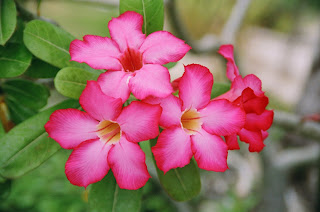 The resort was cozy and laid-back. We ordered breakfast. The place is also full of local flowers such as hibiscus, calachuchi and yellow bells.
The resort was cozy and laid-back. We ordered breakfast. The place is also full of local flowers such as hibiscus, calachuchi and yellow bells.The Excavation Team
After breakfast, we walked from Club Fort Med to the Boljoon Church. There were still many people watching as the excavation team were working. This time, I had a short chat with the woman who instructed that the charcoals in the pit are not supposed to touched.
Her name is Amalia de la Torre. She is formerly from the University of San Carlos and is now a Researcher 2 for the Archaeology Division of the National Museum of the Philippines.
According to her, they had divided a large area of the church yard by 2-meter squares and randomly selected areas for excavation. As to how they knew that there will be some artifacts in the area, she relates that when the church was renovated in 2000 (and declared as a national cultural treasure), someone from the National Museum did an archaeological survey and had initial findings that the area may have more artifacts of cultural and historical value.
I also had a short chat with Jojo Bersales from the Dept. of Sociology and Anthropology of the University of San Carlos that the excavation is part of his doctorate thesis. The National Museum is involved since it is illegal to do archaeological excavations without representatives from the National Museum.
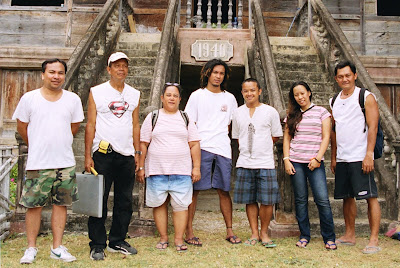 After a while, the excavation team headed for lunch. Rose took the initiative of reconfirming their names and we got them to pause for a picture.
After a while, the excavation team headed for lunch. Rose took the initiative of reconfirming their names and we got them to pause for a picture.
[Above, standing from left to right: Jojo Bersales (USC), Jose Santiago (Researcher 1 and Artist Illustrator, Archaeology Div., National Museum), Amalia de la Torre, Jayryl Murados (USC student), Dennis Brian Bait-it (USC student), Rule Amethyst Oporto (USC student) and Jonathan Jacar (Senior Technician, Archaeology Div., National Museum)]
My thoughts
This is the first time for me to see an actual archaeological excavation. This is significant for me being a lover of history and who onced dreamed of being an archeologist among many other dreams. It turns out that my trip to Boljoon was worth more than "postcards".
I have not been seeing the news lately and I was not able to follow further developments on the finds in Boljoon.
The other night I have seen a documentary on treasure hunting. Archaeologists are much like treasure hunters. They do prior research and follow old clues and trails. The difference lies in the treatment of the treasures. Whereas treasure hunters set aside bones and go for black-market objects, archaeologists treat human remains with respect and interest for study, artifacts with utmost care so as not to add scratch or blemish and with high regard for the value of bridging the gap between the present and the past.
According to her, they had divided a large area of the church yard by 2-meter squares and randomly selected areas for excavation. As to how they knew that there will be some artifacts in the area, she relates that when the church was renovated in 2000 (and declared as a national cultural treasure), someone from the National Museum did an archaeological survey and had initial findings that the area may have more artifacts of cultural and historical value.
I also had a short chat with Jojo Bersales from the Dept. of Sociology and Anthropology of the University of San Carlos that the excavation is part of his doctorate thesis. The National Museum is involved since it is illegal to do archaeological excavations without representatives from the National Museum.
 After a while, the excavation team headed for lunch. Rose took the initiative of reconfirming their names and we got them to pause for a picture.
After a while, the excavation team headed for lunch. Rose took the initiative of reconfirming their names and we got them to pause for a picture.[Above, standing from left to right: Jojo Bersales (USC), Jose Santiago (Researcher 1 and Artist Illustrator, Archaeology Div., National Museum), Amalia de la Torre, Jayryl Murados (USC student), Dennis Brian Bait-it (USC student), Rule Amethyst Oporto (USC student) and Jonathan Jacar (Senior Technician, Archaeology Div., National Museum)]
My thoughts
This is the first time for me to see an actual archaeological excavation. This is significant for me being a lover of history and who onced dreamed of being an archeologist among many other dreams. It turns out that my trip to Boljoon was worth more than "postcards".
I have not been seeing the news lately and I was not able to follow further developments on the finds in Boljoon.
The other night I have seen a documentary on treasure hunting. Archaeologists are much like treasure hunters. They do prior research and follow old clues and trails. The difference lies in the treatment of the treasures. Whereas treasure hunters set aside bones and go for black-market objects, archaeologists treat human remains with respect and interest for study, artifacts with utmost care so as not to add scratch or blemish and with high regard for the value of bridging the gap between the present and the past.
 Note: You may wonder whether the adult skeleton belonged to a man or a woman. Now, the female pelvis is larger than a male's. The width and condition (if it's a female and has given birth) of the pelvic bone most of the time determines sex. In this case, I do not know the width of the artifact's pelvis.
Note: You may wonder whether the adult skeleton belonged to a man or a woman. Now, the female pelvis is larger than a male's. The width and condition (if it's a female and has given birth) of the pelvic bone most of the time determines sex. In this case, I do not know the width of the artifact's pelvis.I have also been searching for the National Museum's official website but there seems to be none. This is a good site though to know further about the repository of our cultural treasures:
http://members.tripod.com/philmuseum/index

